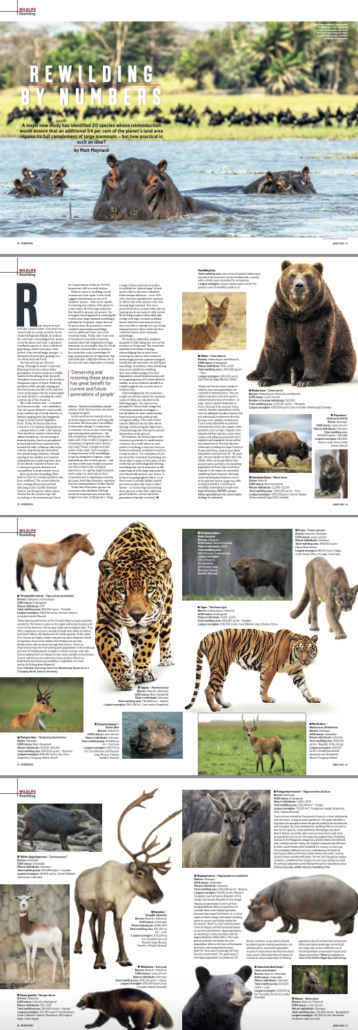Rewilding by Numbers
Geographical magazine. August 2022
A major new study has identified 20 species whose reintroduction would ensure that an additional 54 per cent of the planet’s land area regains its full complement of large mammals – but how practical is such an idea? I investigated for Geographical this August edition, interviewing the scientists behind the study and the animal experts from a dhole expert in India to a reformed puma hunter in Patagonia.
Extract follows
Rody Álvarez doesn’t look like a puma hunter. Crouched over a camera trap on a steep, southern-beech- cloaked Patagonian hillside, he pulls an SD card from a camouflaged box, inserts it into his phone and waits. A pixelated tessellation appears to show a stilettoed pig licking a melted snowman. Fully loaded, a less surreal image emerges – a diminutive huemul deer, grazing on a car-wheel-sized salt block.
The bait and trap are Álvarez’s doing. Although he learnt to hunt and kill pumas from his contract-killer grandfather, today he works as a wildlife warden for Rewilding Chile (formerly Tompkins Conservation) in the northern Patagonian region of Aysén. Bolstering numbers of this critically endangered deer has became his life’s work, and now a new study argues that the animal might just hold the key to rewilding the entire southern tip of the Americas.
The south Andean deer – or huemul as it’s known locally – once inhabited a 166,149-square-kilometre-sized swathe at the southern tip of South America, in habitats ranging from dry Patagonian steppe to broad-leaved Magellanic forest. Today, the huemul has been reduced to 101 isolated subpopulations – a dismal total of 1,048–1,500 animals. Over and above warmer winters from climate breakdown, the fracturing of huemul territory has been precipitated by bacterial infections transmitted by introduced cattle, collisions with motor vehicles, dog attacks and the barbed- wire partitioning of habitats. Huemul existing in the smallest and remotest subpopulations numbering fewer than 20 are already considered extinct due to their poor genetic diversity and susceptibility to freak weather events.
More positively, Rewilding Chile believes that the overall population has been stabilised. The conservationists have strategically purchased land adjoining Cerro Castillo National Park in Las Horquetas Valley, where Álvarez has his camera traps. But according to the International Union for Conservation of Nature (IUCN), huemul are still in overall decline.
When it comes to rewilding, not all creatures are born equal. A new study suggests that huemul are one of 20 ‘keystone’ species – those most capable of restoring vast swathes of the planet to a state where all of the large mammals that should be present, are present. ‘An ecoregionbased approach to restoring the world’s intact large mammal assemblages’, published in Ecography, claims that just 20 species have the potential to restore complete mammalian assemblages
over an additional 54 per cent of the terrestrial realm. Today, only 15 per cent of the planet’s terrestrial ecosystems maintain their full complement of large mammals, an area smaller than the North American continent. But, according to the researchers, intact assemblages of large mammal species are important. Big mammals play a disproportionate role in the structure and composition of natural habitats. Their loss destabilises natural systems, while their recovery can restore ecological integrity….
Read the full article now published by Geographical



